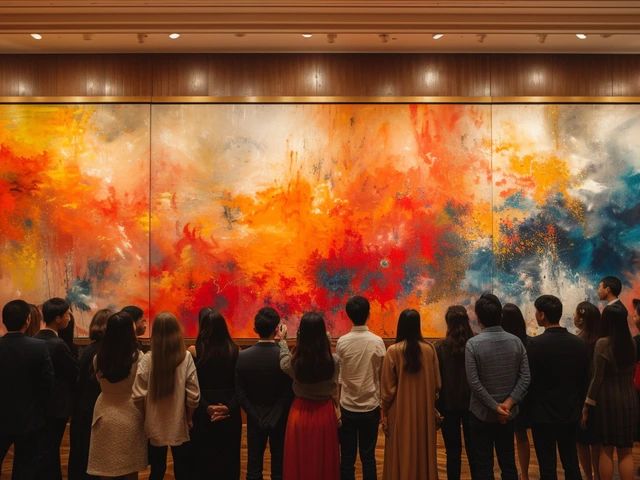At its core, conceptual art prioritizes ideas over form. Unlike traditional art, where the beauty and technique of the artwork are forefront, conceptual art focuses on the concept or idea behind the work. This shift in focus from aesthetic to intellect challenges the observer to think and question, rather than merely observe.
Conceptual art emerged as a movement during the 1960s as artists sought new ways to make narratives and expressions central to their works. It was not just about creating something pleasing to the eye but about engaging the mind, sparking conversation, and questioning norms and perceptions. This article explores the nuances of conceptual art, peeling back the layers of what many might just see as 'complex' or 'indecipherable' art forms. Join us as we journey through the evolution, key players, and ways to appreciate and engage with conceptual art.
- What is Conceptual Art?
- Historical Background
- Key Figures in Conceptual Art
- Interpreting Conceptual Works
- Engaging with Conceptual Art
What is Conceptual Art?
Conceptual art, often viewed as a complex and intellectually challenging art form, fundamentally shifts the focus from the visual craftsmanship of works to the ideas and concepts they convey. Unlike traditional art, where the skillful use of paint and brush create scenes or portraits, conceptual art uses whatever materials and form is seen as best to convey the message. This can often be perplexing to those accustomed to evaluating art through aesthetics alone.
At its inception in the early 1960s, conceptual art became a vehicle for artists to transcend the limitations of physical materials and traditional aesthetics. Instead of asking 'Is it beautiful?', conceptual art prompts deeper inquiries such as 'What does this mean?' and 'Why does this matter?' This art form challenges viewers to engage with the artist's idea and often requires a context or narrative to be fully understood. The beauty in conceptual art is not what you see, but the thought it provokes.
The emphasis on ideas over aesthetic form was a radical departure from conventional art practices of the time, positioning conceptual art as a critique and commentary on the art world itself. Artists like Sol LeWitt, who is often quoted for defining conceptual art, stated,
'In conceptual art the idea or concept is the most important aspect of the work. When an artist uses a conceptual form of art, it means that all of the planning and decisions are made beforehand and the execution is a perfunctory affair.'This succinctly captures the essence of what conceptual art aims to be.
While it might seem that this makes conceptual art less accessible, it actually opens up art to a broader interpretation, allowing for personal and societal reflection. Through this lens, art is not just seen but considered, not just felt, but understood on a deeper, often more controversial level. This aspect of conceptual art has led to some of the most provocative and debate-inspiring works in modern times.
Conceptual art, therefore, serves not only as an expression but as an invitation—an invitation to question, to think, and to engage with art in a manner that goes beyond the superficial. It is an important chapter in the narrative of modern art, reflecting changing attitudes towards creation, interpretation, and the role of the artist themselves.
Historical Background
The inception of conceptual art can be traced back to the early 20th century, however, it was during the 1960s that it emerged as a defined movement. Artists began questioning the traditional boundaries of art, propelled by a desire to shift the focus from aesthetic value to intellectual engagement. This period was rife with social, political, and cultural changes, influencing artists to step beyond existing confines and explore art's potential as a medium for thought and discussion. As traditional forms were considered inadequate for the new ideas they wished to express, conceptual art became a preferred method for many.
Marcel Duchamp, often associated with Dadaism, is widely recognized as a precursor to modern conceptual artists. His piece 'Fountain'—a urinal presented as an art piece—challenged traditional perceptions of what art should be and is considered one of the first instances of Conceptual Art. Duchamp's audacity to posit everyday objects as art simply by placing them in a different context paved the way for future generations of artists to think abstractly about the meaning and purpose of art itself. His work questioned the role of art in society and its relationship with culture, setting a foundational tone for Conceptual Art.
The movement gained greater momentum in the 1960s and 1970s with artists like Sol LeWitt, who is known for his writings and artworks that emphasized 'the idea itself as the art'. His definitions and explanations of Conceptual Art were seminal in shaping the movement. LeWitt's art was not about the singular handcrafted object but about the expression of a thought process. He believed the conception of the idea constituted an artwork, even if its physical manifestation was carried out by others or even left unrealized.
The beauty of conceptual art lies in its ability to liberate expression from physical boundaries and enable artists to engage more dynamically with the viewer through thought-provoking concepts. – Sol LeWitt
Across the Atlantic in Britain, the Art & Language group began using text as the primary medium for their artwork, arguing that language itself could be a means of artistic creation. Their journal, 'Art-Language', became a crucial text in defining the theory and practice of Conceptual Art in Europe. Here, artists like Michael Baldwin and Mel Ramsden spearheaded discussions that challenged the very essence of what it meant to produce and engage with 'art'.
Furthermore, the conceptual art movement questioned everything from the artist's role to the gallery system, influencing contemporary art worldwide. It encouraged a broad spectrum of styles and approaches, all bonded by the central perspective that the idea should drive the creation, not merely the material execution. This philosophical stance continues to intrigue and challenge contemporary artists and patrons alike, maintaining a vibrant relevance in the global art scene.
Key Figures in Conceptual Art
One cannot delve into conceptual art without discussing the pivotal contributions of its key figures. Among these artists, Marcel Duchamp stands as a fundamental pioneer. His piece, 'Fountain', a simple porcelain urinal presented as art, hurled the doors wide open for what could be considered as art, fundamentally questioning the role of the art object and intention of the artist. Duchamp’s audacity established a critical precedent: the idea behind an artwork could possess more significance than the object itself.
Another seminal figure is Sol LeWitt, whose wall drawings and "Paragraphs on Conceptual Art" articulate the philosophy that the idea or concept behind the work takes precedence over its execution. LeWitt’s ideology empowered artists to embrace a broader pallet of expression and form, encouraging experimental approaches no longer confined by traditional materials. His contributions significantly shaped the discourse of art, embedding the concept firmly over aesthetic criteria.
The influence of Joseph Kosuth cannot be understated. His 1965 work, 'One and Three Chairs', expands on Duchamp’s foundation and pushes it into the linguistic realm. Kosuth’s exploration of language and its role in art highlighted how meaning can be disassembled and restructured, engaging the viewer in a dialogue about what is seen and what is perceived. He uniquely showcases how conceptual art can encompass not just visual elements, but intellectual inquest and engagement.
Yoko Ono, another proponent of conceptual art, brought forward a unique blend of performance, instructions, and participation, which were instrumental in the development of conceptual art. Her 'Instruction Paintings' invite the viewer to perform the art themselves, blurring the lines between the artist and audience, and making the process of art creation accessible and interactive. Her work exemplifies the democratic and inclusive nature of conceptual art, opening it to broader interpretations and participations.
The impact these artists have had on the art world is monumental. Each leveraged their unique perspectives and artistic languages to rupture conventional boundaries, inviting audiences to participate not just as observers, but as active interpreters and creators in the artistic process. Their legacies continue to influence contemporary practices, affirming the dynamic and adaptive spirit of conceptual art.
Interpreting Conceptual Works
When embarking on the journey to interpret conceptual works, it's crucial to abandon traditional expectations of what art 'should be.' The essence of conceptual art lies in its ability to provoke thought and engage viewers on a deeply intellectual level. Unlike traditional paintings or sculptures where evaluation might focus on technique and aesthetic, conceptual art demands a different approach. It requires the viewer to ponder the 'why' and the 'how' behind what is presented. This form of art often uses minimalistic or unconventional physical forms to convey complex ideas, challenging the viewer to seek the meaning beyond the visual.
A foundational step in interpreting this kind of art is to understand the context. Knowing the historical, social, or political context within which the art was created can greatly enhance one's understanding of the work. For instance, Marcel Duchamp's 'Fountain'—a porcelain urinal presented as art in 1917—challenges traditional perceptions of art and critiques the art establishment. Recognizing this context allows a deeper appreciation and a clearer interpretation of its intention and impact.
Furthermore, it's beneficial to familiarize oneself with the artist's other works and their overall philosophy. Artists often have recurring themes or ongoing conversations through their works, and understanding these can provide insights into specific pieces. For example, conceptual artist Sol LeWitt, known for his wall drawings and 'Paragraphs on Conceptual Art,' often emphasized the idea over the execution. LeWitt's assertion that 'the idea becomes a machine that makes the art' highlights the primacy of the concept, which is essential to grasp when approaching his and similar works.
Listening to critiques and discussions can also be invaluable. Engaging with critics' views or scholar’s analyses offers varied perspectives that might reveal unseen layers of meaning. At times, a simple shift in perspective induced by another’s thoughts could unveil a whole new understanding of a conceptual piece. It’s a dynamic and evolving process, where discussions and debates play a crucial role in shaping one's interpretation.
Finally, the most essential advice when it comes to interpreting conceptual art is to keep an open mind. The purpose of conceptual art often is to challenge our thinking and preconceived notions. It might confront societal norms or question philosophical truths, thereby opening up endless avenues for interpretation. Keeping an open mind allows these artworks to fulfill their purpose and resonate on a personal level, making the interaction with conceptual art uniquely rewarding.
Engaging with Conceptual Art
The process of engaging with conceptual art can at first seem intimidating. However, with an open mind and the right approach, you will find that it invites an enriching exploration of ideas and meanings. The essence of conceptual art lies not just in viewing an art piece but in interacting with the underlying concepts. Each work serves as a catalyst for thought, often prompting reflections on societal norms, personal identity, or political issues.
Begin by investing time to understand the context in which the artwork was created. Historical, social, and personal influences play a significant role in shaping the message or question that the artist intends to communicate. It's important to consider not only the visible elements but also those that are implied or abstract. This enriched context reveals layers of meaning that might otherwise go unnoticed.
One practical way to engage with conceptual art is to read the artist's statements or accompanying texts. These are often available in galleries or on official websites. Artist statements serve as valuable guides providing insights into their thoughts and intentions. This direct communication can significantly enhance your interpretation, allowing for a deeper engagement with the work.
Another enriching approach is to partake in discussions or art tours focused on conceptual pieces. Dialoguing with others offers multiple perspectives and can illuminate aspects of the work that you might not have considered alone. Such interactions not only deepen understanding but also connect individuals with diverse viewpoints, enriching the overall experience of the art.
Finally, it's beneficial to revisit the same artwork multiple times or over an extended period. Your perceptions and interpretations can evolve, influenced by personal experiences or expanded knowledge, offering a fresh perspective on each visit. This repeated engagement can transform a seemingly enigmatic piece into a source of continuous insight and inspiration.



